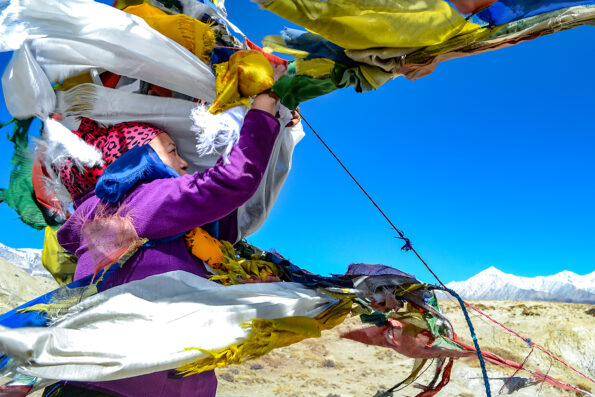
Yam Kumari Kandel, GPJ Nepal
Harka Gharti Magar, 12, draws a picture of a flower in his classroom at the private Shree Gokarneshwor Mahadev Secondary School in Nepal. Few schools in Nepal are equipped to accommodate students with disabilities. Harka is only able to attend his school because a caretaker assists him throughout the day.
KATHMANDU, NEPAL — When he was 9 years old, Harka Gharti Magar found his way into an electrical power substation and fiddled with the equipment. He was electrocuted and lost both of his hands.
Harka’s rural school wasn’t equipped to help him through the day, so he dropped out. His parents, concerned that his disability would cast a shadow on his future, sent Harka with his brother, 25-year-old Khim Gharti Magar, to find a school that could accommodate the boy’s special needs. It took the pair two months to even find a permanent place to live. There are very few handicapped-accessible residences in Nepal’s capital city.
Eventually, they found a rehabilitation center that matched Harka with a caretaker to help him navigate daily life at a boarding school, which is not customized to accommodate disabled people. Harka is now 12 years old, and his family’s efforts have made him one of the lucky ones.
Sixty percent of Nepal’s disabled children are deprived of even basic education, according to a recent interagency-guided report.
It’s not even clear exactly how many disabled children are in Nepal, as multiple studies on the issue have published wildly different results. The 2011 census reported that 1.94 percent of the population had some form of disability, while the National Living Standard Survey for the same year reported 3.6 percent of the population to be living with a disability. Other reports noted much higher rates of disability.



Ganesh Poudel, a deputy director at the Department of Education, says his department uses the 1.94 percent statistic from the 2011 census, meaning that just over half a million Nepalese people are disabled. In 2016, 72,795 disabled students attended school, he says, down slightly from the 73,569 who attended school in 2015.
There are fewer disabled students in higher grades. An estimated 35 percent of disabled students drop out when they’re between the ages of 5 and 10, Poudel says.
There are only 32 schools, scattered around the country, that are specifically equipped to educate disabled students, Poudel says, including 17 for deaf students, five for those with intellectual disabilities and just one for students who are visually impaired.
The Special Education Council met in December to push forward a master plan to improve education access for disabled students, Poudel says. That master plan, which is expected to take a year to draft, is part of a government initiative to ensure equal access to education, which includes a focus on mobility infrastructure and other needs specific to disabled students. The goal is to make all public schools handicapped-accessible, he says.
That could be the beginning of a new era for disabled students in Nepal, their advocates say.
With Doctors and Money in Short Supply, Mentally Disabled Suffer in Rural Nepal
Families in rural Nepal, often isolated and impoverished, struggle to care for children with special needs. Healthcare is scarce in mountain villages and mental healthcare is even harder to find, leaving mentally disabled people without basic treatment or even diagnoses. Read the story.
“The dropout problem among disabled children has been seen mainly due to lack of accessible infrastructure in school and motivating classroom,” says Manish Prasai, administrative manager of the National Federation of the Disabled, Nepal.
Harka was only admitted to Shree Gokarneswor Mahadev Secondary School in Kathmandu because he has a caretaker, says Nikesh Prasad Gautam, the school’s vice principal. The private school has rejected applications from more than 50 disabled students because it doesn’t have the amenities they would need, he says.
Disabled children benefit from being in schools with students who are not disabled, Gautam says. The government should support private schools so they can be retrofitted to accommodate disabled people, he adds.
Poudel, the Department of Education Deputy Director, says the government has urged private schools to build infrastructure that would be accessible for disabled students.
“The issue of equal rights in education is often raised,” says Prasai, the advocate for disabled people, “but the government cannot take any action even when private schools refuse to admit disabled students.”
Sagar Ghimire, GPJ, translated this story from Nepali.







